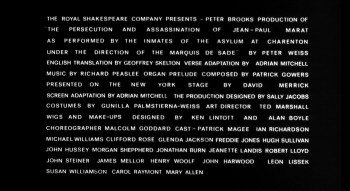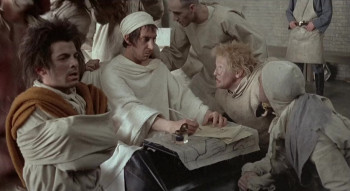Synopsis
July 13, 1808 at the Charenton Insane Asylum just outside Paris. The inmates of the asylum are mounting their latest theatrical production, written and produced by who is probably the most famous inmate of the facility, the Marquis de Sade. The asylum's director, M. Coulmier, a supporter of the current French regime led by Napoleon, encourages this artistic expression as therapy for the inmates, while providing the audience - the aristocracy - a sense that they are being progressive in inmate treatments. Coulmier as the master of ceremonies, his wife and daughter in special places of honor, and the cast, all of whom are performing the play in the asylum's bath house, are separated from the audience by prison bars. The play is a retelling of a period in the French Revolution culminating with the assassination exactly fifteen years earlier of revolutionary Jean-Paul Marat by peasant girl, Charlotte Corday. The play is to answer whether Marat was a friend or foe to the people of France. In the primary roles are a paranoiac with a skin condition (much as Marat had himself) as Marat, a narcoleptic with melancholia as Corday, and a sexual manic as M. Dupere. Coulmier feels he needs to intervene anytime during the performance when things get out of hand. The Marquis may have ulterior motives in the telling of this story, he who plays a large role on stage, especially in his discussions with the Marat character about the nature of the revolution and the differences in their individual motives concerning the revolution. As the inmates perform a story of revolution, they may subconsciously be sucked into the story mirroring their own struggles with authority. Real life and the actors' afflictions may also dictate how the performance turns out.
Director
Cast












